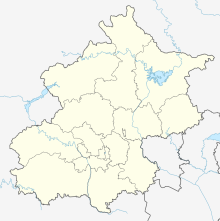
Back Marco Polo-brug-insident Afrikaans حادثة جسر ماركو بولو Arabic Incidente de la ponte de Marco Polo AST مارکو پولو کؤپروسو اوْلایی AZB Инцидент на моста Лугоу Bulgarian Incident del pont Marco Polo Catalan Incident na mostě Marca Pola Czech Episoden på Marco-Polo-Broen Danish Zwischenfall an der Marco-Polo-Brücke German Επεισόδιο της γέφυρας Μάρκο Πόλο Greek
You can help expand this article with text translated from the corresponding article in Chinese. (February 2024) Click [show] for important translation instructions.
|
You can help expand this article with text translated from the corresponding article in Japanese. (October 2019) Click [show] for important translation instructions.
|
| Marco Polo Bridge incident | |||||||
|---|---|---|---|---|---|---|---|
| Part of the Second Sino-Japanese War | |||||||
 Aerial photo of the Marco Polo Bridge (right). Wanping Fortress is on the opposite side of the river. | |||||||
| |||||||
| Belligerents | |||||||
|
| |||||||
| Commanders and leaders | |||||||
|
| |||||||
| Units involved | |||||||
| 29th Army | Japanese China Garrison Army | ||||||
| Strength | |||||||
|
100 troops at the bridge[2] 900 in reinforcement | 5,600[3] | ||||||
| Casualties and losses | |||||||
| 96 killed[2] | 660 killed | ||||||
| Chinese name | |||||||
| Traditional Chinese | 盧溝橋事變 | ||||||
| Simplified Chinese | 卢沟桥事变 | ||||||
| Literal meaning | Lugou Bridge incident | ||||||
| Hanyu Pinyin | Lúgōuqiáo Shìbiàn | ||||||
| Alternative Chinese name | |||||||
| Traditional Chinese | 七七事變 | ||||||
| Simplified Chinese | 七七事变 | ||||||
| Literal meaning | July 7 incident | ||||||
| Hanyu Pinyin | Qīqī Shìbiàn | ||||||
| Japanese name | |||||||
| Kanji | 盧溝橋事件 | ||||||
| Revised Hepburn | Rokōkyō Jiken | ||||||
Location within Beijing | |||||||
The Marco Polo Bridge incident, also known as the Lugou Bridge incident[a] or the July 7 incident,[b] was a battle during July 1937 in the district of Beijing between the 29th Army of the National Revolutionary Army of the Republic of China and the Imperial Japanese Army.
Since the Japanese invasion of Manchuria in 1931, there had been many small incidents along the rail line connecting Beijing with the port of Tianjin, but all had subsided. In this incident, a Japanese soldier was temporarily absent from his unit opposite Wanping, and his commander demanded the right to search the town for him. When this request was refused, units on both sides were alerted and the Chinese Army fired on the Japanese Army. However, the missing Japanese soldier had already returned to his lines. The Marco Polo Bridge incident is generally regarded as the start of the Second Sino-Japanese War.[4]
- ^ "Qin Dechun". Generals.dk. Retrieved 14 May 2015.
- ^ a b Wang Yi (2004). Common Knowledge about Chinese History. Hong Kong China Travel Press. p. 185. ISBN 962-8746-47-2.
- ^ Japanese War History library (Senshi-sousyo) No. 86 [Sino-incident army operations 1 until 1938 Jan.] p. 138
- ^ "Articles published during wartime by former Domei News Agency released online in free-to-access archive". The Japan Times Online. 2018-11-02. ISSN 0447-5763. Archived from the original on 2019-06-04. Retrieved 2019-06-04.
Cite error: There are <ref group=lower-alpha> tags or {{efn}} templates on this page, but the references will not show without a {{reflist|group=lower-alpha}} template or {{notelist}} template (see the help page).
